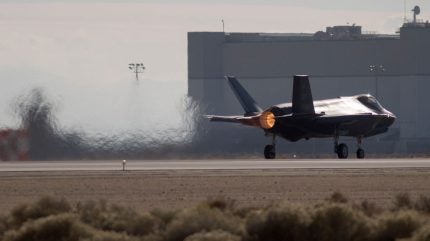
The F-35 Lightning II joint strike fighter will take on the Nato’s nuclear role for the first time on 1 June 2024, as the Royal Netherlands Air Force (RNLAF), one of few Nato Allies contributing dual-capable aircraft to this mission, transfer the task from its F-16 fighters to the new fifth-generation airframe.
The step up to the F-35 stealth aircraft mitigates issues surrounding the credibility of Nato’s nuclear deterrent. To date, the nuclear deterrent has been a system of American made B-61 gravity bombs dropped by F-16 fighters that would rely on mass to penetrate significant air defences, and be dependent on coordinating a mid-air refuel operations in order to travel to targets at significant distances.
In any second-strike scenario wherein an initial nuclear attack has led to complications in the adoption of an orderly course of action, the surety of delivering a retaliatory strike via dual capable aircraft was not guaranteed by the performance of the F-16 fighter.
The F-35, in contrast, is in possession of several systems that lift Nato’s nuclear deterrent credibility. Its stealth capabilities and advanced sensor suite allow it to course through air defences, applying electronic warfare tools to suppress and jam adversary radar, and then locate targets accurately for the pilot.
This stealth capability is of particular advantage in the context of a Europe grappled in conflict on Nato’s Eastern Flank. The War in Ukraine has seen a ramping up of multi-layered air defences by Russia, leading to a state of mutual air denial. For much of the war, air supremacy, long a doctrinal aim of air forces internationally, was swept aside.
For both parties in the conflict, the use of air assets was contingent on ground support to secure the airspace from effective surface-to-air munitions, hence high-value platforms were consigned to close-support missions, while stand-off weapons including drones and cruise missiles operated as the principle long range strike capability.
The F-35 has been proven as an adept ISR platform during Nato’s policing missions, classifying and geolocating the electronic signals that serve as the whiskers of effective air defence. When coupled with the F-35’s stealthy profile and capability to suppress radar, the technological advances offered by this airframe provide Nato with far more credible nuclear deterrent.
Advances in payload technology, as the B-61 gravity bombs are modernised to the B61-12, equipped with an inertial guidance system and GPS, also length strength to the profile of Nato second-strike missions.
The RNLAF began the transition from the F-16 to the F-35 began in 2012 with the first flight of a Dutch F-35 at Fort Worth in Texas, but it was not until 2016 that Netherlands’ F-35 tester aircrafts first touched down on Dutch soil. The first operational Aircraft were delivered in 2019, fulfilling a contract signed in 2015 for eight F-35s. Netherlands maintains the aim of purchasing at least 46 new fighter aircraft.
While the F-35 has already been used for conventional tasks by the RNLAF, it is only in recent years that the airframe has undergone the certification process for the nuclear deterrent role. Netherlands will be the first European country to use it in this capacity, housing the dual-capable F-35 aircraft on Nato’s nuclear deterrent mission at Volkel Air Base, the site previously used by F-16 aircraft for the same role.



